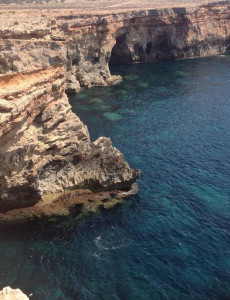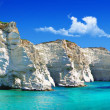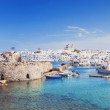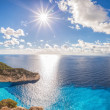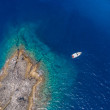
Spain
About Spain
Spain is at the same time a stereotype that comes to life and a country that is more different than you've ever imagined.
Spain is the second most visited country in the world (immediately after France). No wonder given its variety and beautiful life, from stone castles, to mountains, and to sophisticated cities full of monuments. Spain is located in the most south-western part of Europe occupies 85% of the Iberian peninsula (bordering on Portugal and separated from France by the beautiful mountain range of the Pyrenees), the Spanish people of about 46 million have innumerable traditions that range from the religious ones, to the famous bullfight to the most extreme and unimaginable ones like the Tomatina (the throwing of tomatoes in the town of Buñol), the processions of San Firmino (with the mad rush of the bulls in the streets of Pamplona) etc etc.
Landscapes ranging from the Sierra Nevada mountains to the warm plains of Andalusia and the famous Atlantic and Mediterranean coasts with over 8000km: Costa Calida Costa del Sol, Costa de la Luz, Costa Brava, Costa Dorada, Costa Blanca, Azahar Coast.
Madrid
Capital of Spain, and city of the royal family: you immediately understand it from the great boulevards and the sumptuous architecture. In addition to the immense Museo del Prado, in Madrid a mandatory visit to the Reina Sofia Museum to admire the masterpiece of Picasso, Guernica, the Royal Palace and the Matadero Cultural Center, south of the city.
Barcelona
The capital of Catalonia always has something to offer: be it the marvelous buildings designed by Gaudí, the interesting exhibitions of the MACBA, or the development of Picasso's artistic path in the museum dedicated to the painter Malagueño in the Barrio Gotico.
Seville
In the capital of Andalusia, in addition to relaxing with long walks and excellent tapas, do not miss a visit to the Cathedral, the largest Christian church in the world, which houses the presumed - remains of Christopher Columbus. Climb to the top of the bell tower, called Giralda (one of the minarets that were part of the original mosque that once stood here), and then refresh yourself in the gardens of the Alcázar, the residence of many generations of kings and caliphs.
Granada
The Alhambra Palace in Granada - together with the Generalife Gardens - is the most visited monument in Spain, and its beauty fully justifies it. Between a tapas and a fresh cerveza, visit also the Cathedral, the Capilla Real, and the Sacromonte Quarter, where Flamenco was born.
Santiago de Compostela
The actual capital of Galicia, but also the spiritual capital of Spain, Santiago de Compostela is the point of arrival of the famous and homonymous Way, a pilgrimage that crosses all of northern Spain to reach the Tomb of St. James in the Cathedral of Santiago. WIthout mention towns like Valencia, San Sebastían and Cordoba definetely worht to see.


Our recommended yacht cruises in Spain
The main islands of Spain are divided into two archipelagos; the Balearic Islands and the Canary Islands (which are located in the Atlantic Ocean). The Balearic Islands with the famous Ibiza represent a major summer destination in Spain. The best way to visit these beautiful islands very different from each other is with a boat cruise (both embarking directly in Mallorca, Menorca and the renowned Ibiza and Formentera both from Barcelona and Valencia). Especially between Ibiza and Formentera in high season not only do you avoid the crowds of the island and reach places accessible only by land, but you can also save money compared to a hotel.

History
Rovine romane spazzate dal vento, cattedrali di rara potenza e gioielli incomparabili di architettura islamica parlano di un paese in cui le grandi civiltà della storia sono sorte, sono cadute e hanno lasciato il segno indelebile. Più recentemente, quale altro paese potrebbe produrre spiriti così ribelli e inesorabilmente creativi come Salvador Dalí, Pablo Picasso e Antoni Gaudí e metterli al centro della vita pubblica? E qui, grandi monumenti della storia coesistono accanto a creazioni architettoniche di tale audacia che diventa chiaro che il futuro della Spagna sarà altrettanto originale come il suo passato.
Nell’antichità (dal X secolo a.C.) le popolazioni autoctone dovettero fare spazio a dominatori esterni (Fenici, Greci, Iberi e Celti). Negli ultimi decenni del III secolo a.C. il territorio ispanico divenne un campo di battaglia fra Cartagine. Il Cristianesimo giunse molto presto nella penisola (II–III secolo) e vi si impiantò saldamente.
Nell’VIII secolo l’Islam fece la sua comparsa in Spagna, annientando il Regno visigoto e dominando la massima parte della penisola per secoli, senza riuscire però a cancellare l’impronta latina e le credenze cristiane delle popolazioni autoctone. Nel 1492, si affermarono due Stati cristiani come grandi potenze in età bassomedievale: il Regno di Castiglia e il Regno di Aragona. Tuttavia solo dopo la morte di Carlo V (Carlo I di Spagna), con l’avvento degli Asburgo e in particolare nella seconda metà del XVI secolo il regno assunse definitivamente in tutta Europa il nome di Spagna (o di Spagne). Dopo l’emanazione dei Decreti di Nueva Planta (1707–1716), avvenne una vera e propria unione politica fra tali Stati e l’inizio di un lento processo di fusione che, in alcune regioni, si è protratto fino ai giorni nostri (e, in alcuni casi, non si è ancora concluso). Grande potenza della politica europea e mondiale per oltre tre secoli, fino al Congresso di Vienna, la Spagna perse nel secondo e terzo decennio dell’Ottocento quasi tutto il proprio impero coloniale, acquisendo un ruolo sempre più marginale rispetto alle nuove grandi potenze europee. Nell’epoca liberale si accentuarono inoltre i conflitti politici interni, sia dinastici che territoriali. Negli anni trenta del XX secolo la Spagna fu una repubblica laica e quasi federale, rovesciata, dopo una sanguinosa guerra civile (1936-1939), da una dittatura militare nazionalista guidata dal generale e poi Caudillo Francisco Franco. La dittatura ebbe termine solo quarant’anni più tardi con la morte di Franco (1975) e l’ascesa al trono di re Juan Carlos.
Weather in Spain
June is the hottest month in Havana with an average temperature of 27°C (81°F) and the coldest is January at 21°C (70°F) with the most daily sunshine hours at 11 in July. The wettest month is June with an average of 80mm of rain. The best month to swim in the sea is in August when the average sea temperature is 30°C (86°F).
Check all Statistics in AccuweatherDec
Jan
Feb
Mar
Apr
May
Jun
Jul
Aug
Sep
Oct
Nov
All destinations in Mediterranean Sea
-

-

-

-

-

-

-

-

-

-

-

-

-

-

-

-

-

-

-

-

-

-

-

-

-

-








